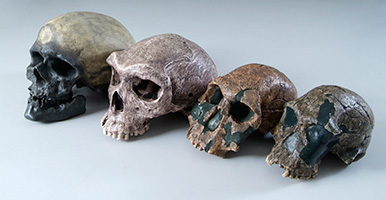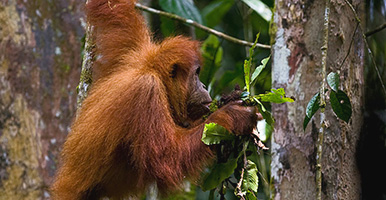Contexts of human evolution
Exploring the changing place of humans in nature
Our research focuses on the archaeological, palaeontological and environmental analyses of human evolution.
Our research focuses on mammalian evolution, hominin behaviour and ecology, and patterns of faunal and floral distribution. We are interested in taxonomic, ecological and morphological studies of mammals, particularly ungulates and carnivores, from the Neogene onwards. Areas of particular strength include palaeoecological analyses (including taxon-free approaches), the evolution of carnivores and ungulates, biomechanical and morphological analyses and biostratigraphy. We examine the extent to which human evolution was driven by external events, the influence of which extended beyond human activity and impacted upon the entire biota. We are also engaged in studies of Plio-Pleistocene and Holocene climate change using a variety of proxies such as testate amoebae (also known as rhizopods), pollen, diatoms, fungal spores and ecomorph abundance. Group members have been active in both the Old and New World and are currently working on a series of field and laboratory projects throughout the Old World and South America (Brazil).
Research areas and current projects
-
Ecogeographical variation of South American mammals
The primary objective in studying the ecogeographical variation of South American mammals is to understand the role of the Amazonian forest and the Cerrado biome in favouring particular morphological adaptations on different mammalian lineages. (Dr Carlo Meloro. Funded by British Council Researcher Links 127432108) - Homa Peninsula Palaeoanthropology Project
We are exploring Oldowan hominin behaviour and palaeoecology in Kenya. Excavations at Kanjera South are recovering rich concentrations of ca. 2.0 million year old Oldowan artifacts and fossils in several excavations, providing a new, major Oldowan assemblage with both artifacts and well-preserved fauna. Numerous other localities have been discovered and are slated for further exploration and excavation. (Prof Laura Bishop, Dr Elizabeth Whitfield. Funded by the National Science Foundation)
Facilities
- Pollen and fungal spore laboratory – to extract and analyse micropaleontological samples
- Molecular biology research laboratories – equipped with a fume hood, thermocyclers, electrophoresis systems, centrifuges, scales, thermal blocks, water baths, Milli-Q system, Real-Time PCR system, nanodrop and several fridges and freezers. Illumina sequencing is performed at the Centre of Genomic Research at the University of Liverpool.
- Our labs offer opportunities to use digital calliper, digital photography, microscribe, laser scan next engine and software for shape analyses. In collaboration with LJMU’s General Engineering Research Institute (GERI) and the University of Liverpool and Natural Environment Research (NERC) we also offer the opportunity to perform microwear analyses on mammalian teeth, Finite Element modelling and isotopes.
Current collaborations
- University of Liverpool
- University of the Balearic Islands
- China Jiliang University
- Université Cadi Ayyad
- General Engineering Research Institute (GERI), LJMU
- University of Zurich
- Università degli Studi del Molise
- Università di Firenze
- Università degli Studi di Napoli “Federico II”
- Hull York Medical School
- Max Planck Weizmann Center for Integrative Archaeology and Anthropology
- Università Roma 3
- University of Durham
- University of Queensland
- National Museum of Scotland
- Universidade Federal de Santa Maria
- City University of New York
- New York Consortium in Evolutionary Primatology
- The George Washington University
Publications
Search publications on this topic:
Loading publications…
People
Meet the researchers within this theme:








